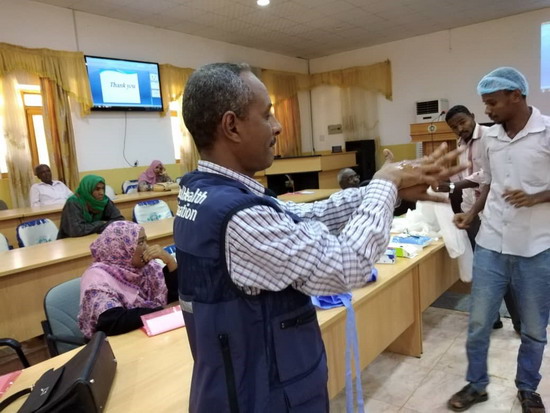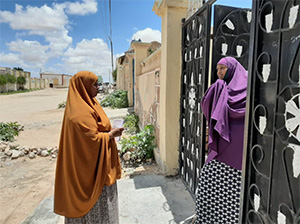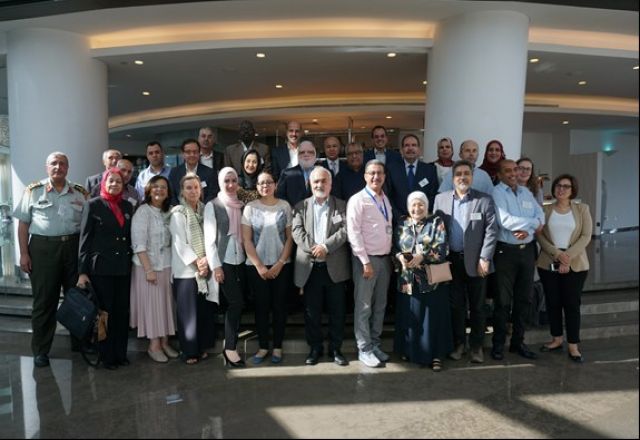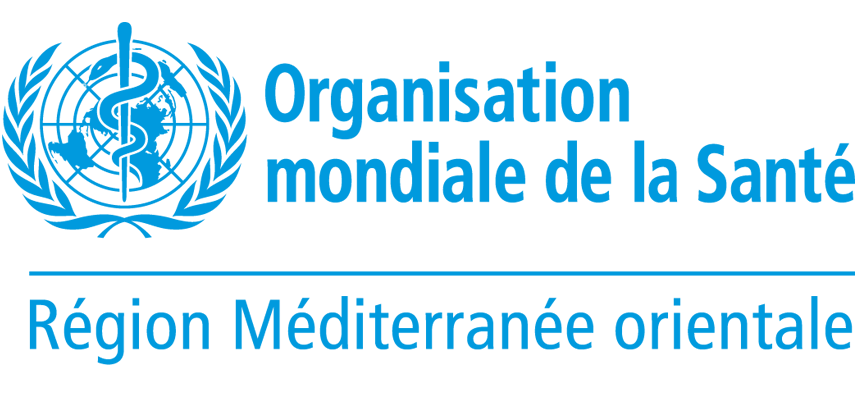Training health workers to fight COVID-19 in Sudan
Polio personnel are putting in the hours to strengthen response
 Dr Niazy trains medical staff on handwashing during a COVID-19 training session in River Nile state. Photo: WHO/Sudan
Dr Niazy trains medical staff on handwashing during a COVID-19 training session in River Nile state. Photo: WHO/Sudan
28 May 2020 – The polio eradication programme has stepped up to help the Sudanese Ministry of Health limit spread of the COVID-19 virus. The programme is working in 14 states in the country supporting COVID-19 surveillance, information dissemination and training of health workers.
Dr Niazy Abd Alhameed Abd Alwahab, a National Medical Officer for the polio programme since 2013, is one of the personnel playing a key role. He and colleagues recently led 2 WHO COVID-19 trainings in River Nile state, one for rapid response teams and one for local hospital staff, in addition to supporting training run by the State Ministry of Health.
Thanks to the training, health workers in all 7 localities in the state are ready to help individuals who are showing symptoms of COVID-19. In total, more than 3000 rapid response team members have been trained across Sudan with support from polio National Medical Officers.
By early May, River Nile state had suffered 7 cases of COVID-19, with 2 fatalities. “The state is organized to respond,” Dr Niazy explains, “All patients are being treated in dedicated isolation facilities in hospitals, and medical staff are on high alert for more cases. We helped train teams so that they are able to serve the population.”
Training rapid response teams
A 5-day training of rapid response teams, funded by WHO, was targeted at 7 teams, one from each state locality. Of the 42 individuals trained, 30 were women and 12 were men. The teams have been created for the COVID-19 response. Each team contains individuals with the collective public health experience to contribute to local efforts to fight the virus, spearheading work in contact tracing and engagement with the community.
The first day of training was attended by the Director General Health of the State Ministry of Health and the Head of the Emergency Humanitarian Assistance department.
Dr Niazy explains that over the 5 days, participants gained a comprehensive understanding of Sudan’s COVID-19 surveillance and contact tracing systems, infection prevention and control practices, case management methods, and how to collect samples and arrange shipment to the national laboratory in Khartoum. Participants were also trained on how to use PPE safely and how best to wash their hands.
“Participants were encouraged to take part in interactive exercises to test and strengthen their knowledge, as well as take part in discussions,” he says.
“By the end of the training, all participants were fully trained and able to pass on their knowledge in their localities.”
Training local health staff
The polio programme also supported a 2-day COVID-19 training for 34 women and 22 men who work in state hospitals as doctors, laboratory technicians, or other medical personnel. The programme continues to support the State Ministry of Health with further local training, including for medical registrars.
Ongoing challenges
The situation in River Nile state is very challenging. There are chronic shortages of PPE, hand sanitizer and masks, and WHO is offering urgent support to help procure these. Severe shortages of fuel and currency are making response more difficult. Social norms in some communities dissuade individuals with COVID-19 symptoms from seeking medical assistance, and work must be carried out to build trust and ensure people with COVID-19 are found and offered care.
To serve the COVID-19 response and prevent virus spread, the polio eradication programme has had to scale back some of its usual work. Dr Niazy explains, “Vaccination campaigns are paused, and many private clinics are closed, some of the public health centres are turned into isolation centres as part of the response to this emergency. This makes detecting acute flaccid paralysis (AFP) more difficult, as health personnel are trained to report children with AFP who come to the health centres.”
Efforts are being made across the Eastern Mediterranean Region to minimize the impact of COVID-19 on the overall health of populations, during a time when many health activities cannot go ahead. In Sudan, a number of children do not have full immunity against polio, and it is critical that routine immunization continues where possible until vaccination campaigns can resume.
Dr Hoda Youssef Atta, acting WHO Representative, explains, “During the COVID-19 emergency the polio eradication programme is committed to providing expertise, training and medical skills to protect Sudan. However, as soon as it is safe to do so, we must scale up programme operations once more to protect vulnerable populations from polio.”
Somalia’s polio teams help combat COVID-19
 Polio programme staff are conducting disease surveillance for COVID-19 as well as educating communities on the symptoms of the virus, how to prevent transmission, and how to report suspected cases. ©WHO/Somalia4 May 2020 – “The road to the mountain village was rough. It’s only 50 kilometres, but it took more than 3 hours,” says Dr Fatima Ismail, a disease surveillance officer working in Somaliland. “We were bouncing in the car.”
Polio programme staff are conducting disease surveillance for COVID-19 as well as educating communities on the symptoms of the virus, how to prevent transmission, and how to report suspected cases. ©WHO/Somalia4 May 2020 – “The road to the mountain village was rough. It’s only 50 kilometres, but it took more than 3 hours,” says Dr Fatima Ismail, a disease surveillance officer working in Somaliland. “We were bouncing in the car.”
In early 2020, Dr Fatima’s team headed to a remote village near Djibouti to check on a small boy. The boy’s right arm and leg showed a kind of paralysis that sometimes indicates polio. “The village polio volunteer in this mountainous area, geographically inaccessible, found an acute flaccid paralysis (AFP) case,” Dr Fatima remembers.
When children show signs of this paralysis, it’s critical to get stool samples to a laboratory to determine whether they have polio. Polio teams ride camels in the desert or donkeys in the mountains when they have to. They brave bombs to get samples out of conflict zones to laboratories. In brutally hot climates, they plug mini-freezers into car dashboards to keep samples cool.
All over the world, polio surveillance systems that have been built up over decades track infection sources, evaluate symptoms and transport samples to the laboratory — despite distance, natural disasters, and sometimes war. Now, this network of disease surveillance — reaching into the most far-flung corners of the globe — is being tapped to address the COVID-19 pandemic.
“In Somalia, the polio programme pivoted its workforce of thousands of frontline staff to support the effort as the cases of COVID-19 spread. Rapid response teams — made up of disease surveillance officers, community health care workers and volunteers — were trained to educate people about the virus and to test suspected cases. By April 2020, the teams were deployed in the field,” said Dr Mamunur Malik, WHO Representative in Somalia.
Polio eradication staff support COVID-19 response
April 2020 – Using the vast infrastructure developed to identify the poliovirus and deliver vaccination campaigns, the polio eradication programme is pitching in to protect the vulnerable from COVID-19, especially in polio-endemic countries. In Pakistan and Afghanistan, as well as worldwide, the programme is drawing on years of experience fighting outbreaks to support governments as they respond to the new virus.
Considering Primary Immune Deficiency in the Eastern Mediterranean Region
 Attendants of the Regional Meeting on Poliovirus Surveillance among Primary Immunodeficiency Patients in the Eastern Mediterranean Region, 28 – 30 October 2019, Amman, Jordan. ©WHO/EMRO
Attendants of the Regional Meeting on Poliovirus Surveillance among Primary Immunodeficiency Patients in the Eastern Mediterranean Region, 28 – 30 October 2019, Amman, Jordan. ©WHO/EMRO
20 February 2020 – In line with the Strategic Advisory Group of Experts (SAGE) recommendation and the Global Strategic Surveillance Action Plan 2018-2020, WHO EMRO and GPEI partners conducted the Regional Meeting on Poliovirus Surveillance among Primary Immunodeficiency Patients (PIDs) between 28-30 October 2019 in Amman, Jordan.
The meeting aimed to develop national plans for PID surveillance and identify next steps to roll out PID surveillance in selected countries. The lessons learnt from phase I implementation of the project will be used to implement PID surveillance elsewhere.
Dr Hamid Jafari, Director for Polio Eradication at WHO/EMRO, joined the opening session, and welcomed delegates from the four countries attending the meeting: the Arab Republic of Egypt, the Islamic Republic of Iran, the Republic of Tunisia, and the Hashemite Kingdom of Jordan. He also welcomed facilitators from WHO/HQ and partners from the US Centers for Disease Control and Prevention (CDC) and the Bill & Melinda Gates Foundation (BMGF), expressing his appreciation towards their efforts in polio eradication.
The countries were selected based on a Global Risk Assessment considering several risk factors for PIDs including: Consanguinity, occurrence of immuno-deficiency associated vaccine-derived poliovirus (iVDPV), oral polio vaccine (OPV) immunization rates, PID survival rate, previous experience with and inclusion in study projects, and experience with antiviral drug use.
PIDs are a group of up to 350 known diseases, which are caused by genetic defects of the immune system. A few types of PIDs are known to be associated with risk of prolonged excretion of viruses and subsequently their spread. This is a real threat for the polio programme after eradication, as children will become more vulnerable to infection with polio as immunity levels wane after cessation of polio vaccination. If polio is no longer present in the wild, this is not a problem, but if virus is unintentionally reintroduced to the environment by a PID patient, cases of paralysis could occur once again.
Dr Jafari noted that the significance of immune deficiency-related vaccine-derived polioviruses (iVDPV) has been recognized for several years. Treating those with PIDs is an important component of the 2019 – 2023 Endgame Strategy for the Global Polio Eradication Initiative.
Discussion at the meeting focused on reviewing the current situation of survey-based PID surveillance in the region. Countries presented their experience of antiviral introduction policies, mapped ways to ensure sensitive high-quality surveillance systems, and identified the next steps for effective operationalization of PID surveillance. The intention was to propose a public health response that reduces both individual risk of developing poliomyelitis and the risk to the community of poliovirus transmission. The Regional Office demonstrated a developed information system to support implementation of PID surveillance in the four countries at the meeting.
Key actions were agreed by countries, the WHO regional office, and the Global Working Group to complete over the coming months.
This is just the beginning of a long-term project to consider the needs of PID patients and their communities. By building strong relationships between different involved parties, progress can be made to detect and protect PID patients now and ensure that sturdy foundations are laid for supporting patients after the certification of polio eradication.
For more information on the discussions and outcomes of the meeting, please contact Dr. Muhammad Obaid-ul Islam Butt, Medical Officer for Surveillance, at buttmu[AT]who[DOT]int, or Dr. Ashraf Wahdan, Medical Officer for Certification and PID focal point, at wahdana[AT]who[DOT]int.


